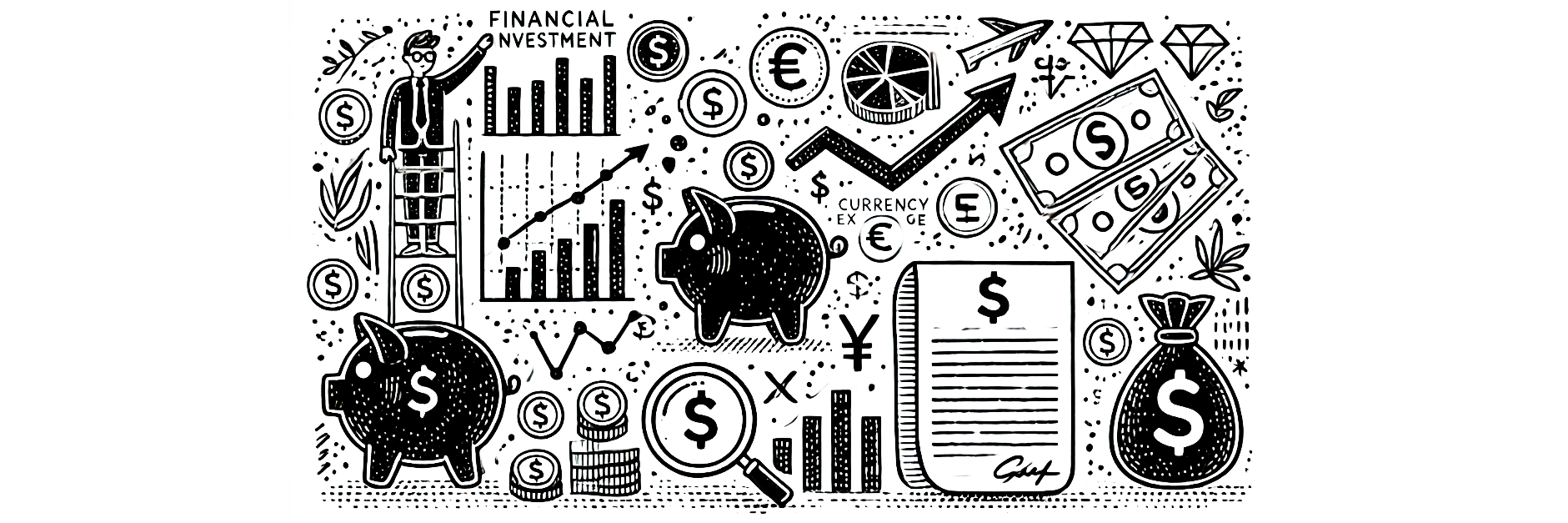Is Chocolate Finance’s New US$ Account Worth It?
With high-interest-rate environments making USD deposits increasingly attractive, Singapore-based fintech Chocolate Finance has launched a new USD interest rate product that promises up to 4.6% per annum. The offer has caught the attention of savers and investors alike, especially those looking for alternatives to fixed deposits, money market funds, and US Treasury bonds.
However, as with any financial product offering high returns, questions arise.
- How does Chocolate Finance generate these returns?
- Is it a safe investment?
- Are these returns sustainable?
- What risks should investors be aware of?
- How does the USD/SGD exchange rate impact earnings?
In this article, let’s deep-dive into Chocolate Finance’s new USD product, explain how it works, what it invests in, so that you can decide for yourself whether it’s a good fit for your investment strategy.
Every week, I’ll be sharing practical tips and invaluable knowledge to guide you on your path to financial independence.
What Is Chocolate Finance’s New USD Product?
At its core, Chocolate Finance’s USD product is a high-yield cash management account, where customers deposit USD and earn daily interest. Unlike fixed deposits that require locking up funds, this product offers liquidity and no minimum deposit requirements.
Key Features of Chocolate Finance’s USD Product
- No lock-in period – Withdraw funds anytime without penalties.
- Daily compounding interest – Interest accrues and is credited daily.
- Tiered interest rates – Up to 4.6% per annum.
- MAS-regulated – Operates under a financial license.
Interest Rate Breakdown
|
Deposit Amount |
Interest Rate (p.a.) |
|---|---|
|
First US$20,000 |
4.6% |
|
Next US$30,000 |
4.2% |
|
Balances above US$50,000 |
4.2% |
Is Chocolate Finance Legitimate and Regulated?
Chocolate Finance is a licensed financial institution under the Monetary Authority of Singapore (MAS). However, it is important to highlight that:
- Foreign currency deposits are NOT covered by the Singapore Deposit Insurance Corporation (SDIC). Unlike SGD bank deposits, investments in Chocolate Finance are
not protected if the company ceases operationsremains separately custodised (ringfenced) and you can still withdraw it anytime (Updated thanks to clarifications from Chocolate Finance). - This is NOT a bank deposit. This product is an investment, not a savings account. Investors face risks such as bond yield fluctuations and foreign exchange risk.
Unlike traditional fixed deposits, Chocolate Finance’s product carries market risks. Returns are dependent on bond market performance, which can fluctuate.
How Does Chocolate Finance Generate These Returns?
Chocolate Finance invests customer deposits into short-term, investment-grade bond funds and retains the surplus yield collected after distributing the promised interest returns. These funds aim to provide a stable yield while keeping duration short to manage interest rate risks.
These are the four main bond funds that the product will be invested in:
- Dimensional Short Term Investment Grade USD Fund (DSF)
- Fullerton Short Term interest rate USD Fund (FST)
- LionGlobal Short Duration Bond USD Fund (LGF)
- abrdn SICAV I Short Dated Enhanced Income USD Fund (ASF)
These bond funds are not unique to Chocolate Finance and you can create your own portfolio of bond funds using them in other investment platforms as well if you wanted to.
What we want to take note here is that that these bond funds are investing in short term bonds across the globe that mature in less than 5 years. Short term bond prices are less volatile to interest rate fluctuations, compared to long term bonds. As these bond funds are actively managed, the management fees (as well as other underlying costs) are much higher than the passive ETFs that many are used to seeing.
Are the Returns Guaranteed?
The returns are NOT guaranteed. However, Chocolate Finance has a ‘Top-Up Programme’ where they have committed to topping up returns if bond yields fall below the target return (up to US$50,000 deposits) during the promotional Qualifying Period (from now until 31 March 2025, or until the assets under management for the Chocolate Managed Account reach S$1 billion—whichever comes first).
However, this does not guarantee long-term sustainability. If bond yields decline significantly, Chocolate Finance may:
- Reduce its advertised interest rates (like what they have done with the SGD product).
- Stop the top-up programme.
- Increase its risk exposure to maintain returns.
Investors should not assume that rates will remain fixed forever.
How Do Currency Movements Affect Returns?
Since the product is denominated in USD, investors who convert back to SGD are exposed to foreign exchange fluctuations. This currency risk is fully bore by the investors and not by Chocolate Finance so I have created a table below that hypothesised what happens if the USD were to appreciate or depreciate against SGD.
The following table separates capital and interest components to illustrate how USD/SGD exchange rate movements impact final returns, assuming an investment of US$10,000 at USD/SGD rate of $1.3495.
|
Scenario |
Capital Invested (SGD) |
Interest Earned (USD) |
USD/SGD Rate Changes |
Capital Return (SGD) |
Interest Return (SGD) |
Total (SGD) |
|---|---|---|---|---|---|---|
|
USD Appreciates (+5%) |
S$13,495 |
$481.19 |
1.4170 |
S$14,170 |
$681.85 |
$14,851.85 |
|
Current Rate (USD/SGD $1.3495) |
S$13,495 |
$481.19 |
1.3495 |
S$13,495 |
S$649.37 |
$14,144.37 |
|
USD Depreciates (-5%) |
S$13,495 |
$481.19 |
1.2820 |
S$12,820 |
$616.89 |
$13,436.89 |
The TLDR here is that:
- If USD strengthens, investors gain in SGD terms.
- If USD weakens, SGD returns fall, which could wipe out part of the interest earned and if worse, impact your invested capital as well.
This is especially important for Singaporeans who are most likely to eventually convert their USD holdings back to SGD.
Would I Invest in Chocolate Finance’s USD Product?
Chocolate Finance’s USD product is an interesting alternative to traditional fixed deposits and money market funds, offering higher returns with daily compounding and no lock-in period. The fact that it is MAS-regulated and managed by an experienced team adds credibility. However, despite its attractive returns, the investment does come with risks that cannot be ignored.
One key concern for me, is the lack of capital protection. Like foreign currency deposits in banks, this product offered by Chocolate Finance is not covered by the SDIC insurance, which means that if the company were to face financial difficulties, investors could lose their funds. Additionally, the returns are not guaranteed and depend on the performance of short-term bond funds. If bond yields fall, Chocolate Finance may be forced to lower the advertised rates or take on additional risk to maintain returns. Investors should also consider foreign exchange fluctuations, as the USD/SGD rate will impact the final returns when converting funds back to SGD.
Is This a Good Investment?
Chocolate Finance’s USD interest rate product is not a fixed deposit, but a cash-like investment option that offers higher returns with some risks. Investors must weigh the pros and cons of bond market exposure and currency fluctuations.
Would you consider investing in this? Let me know in the comments! 🚀
PS: Since I will be joining iFAST Global Markets as an investment advisor, you can always schedule a call with me if you would like to discuss your investment strategies in more detail.


Yes, growing wealth via USD denomiated products helps us to earn the arbitage between US and SG. Even USD REITs on SGX are going at 8-9%, similarly HKD REIT (HKD pegged to USD) are going at 8% yield depsite these REITs being of lower gearing and more diversified than Singapore’s REITs. This is due to the much lower risk free rate of Singapore vs the world. Singapore investors should not be investing in Singapore. Assets of the same class and risk profile in HKD and USD are giving at least 2%, I myself dont hold Sing Dollar anymore and have started holding USD and HKD, indeed I am earning about 2.5% more than when holding SGD
Your view is valid. What I hope to do is to have my readers understand the risks involved and informed investment decision based on how they view these risks. If they have similar views as you, there’s no reason not to consider the US$ account.
Thanks for writing this out. My assessment is as follows:
1. I identified two key risks:
a. ChocFin’s operations. As this organization is not SDIC protected, I need to make sure I have a backup plan if I see them run into trouble. Threat here is significant permanent capital loss. Thus far, they have been doing alright, but never say never.
b. Top Up programme. A very little known part of Chocolate Finance is that their Top Up programme is a promotional campaign, and the key idea behind this is easy liquidity and fast withdrawal if things go wrong. If ChocFin does not extend their promotion here, it may encourage me to limit my exposure to ChocFin or to take a more measured approach to their interest.
2. On foreign currency risk, the simulation here helped me to argue that the risk isn’t as high on this front:
a. There was only one time when USD depreciated significantly vs SGD and that was September 2024 last year. And based on your simulation, it was only a minor loss. I think it is worth the potential trade-off. (For a loss to be persistent, you need to look back to the period of low interest in the 2010s.)
b. More likely the forex will be maintained or it will strengthen. The Fed is somewhat concerned about Trump’s tariffs undoing the good work of falling prices. I don’t think the currency will weaken yet with this in mind.
I think it is safe to put some money into Chocolate Finance until they clarify their top up programme. After that, depending on what you need, you best keep moving the money if you need it.
Valid points. I would consider the top up programme can be thought of as a promotion campaign as well. As for the FX risk, it’ll definitely depend on how one thinks of the risks and whether they are willing to take it.
“Unlike SGD bank deposits, investments in Chocolate Finance are not protected if the company ceases operations.” Please see Chocolate Finance FAQ on this:
What happens if Chocolate Finance gets acquired, goes public or closes?
Nothing happens to your money! It’s safe and segregated. We understand that the security of your funds is of utmost importance. As a regulated fund manager, and to ensure that your money is safeguarded, we are required to keep it entirely separate from our own finances, and segregated. Whether your funds are in the form of cash or securities, we use the services of al licensed custodian banks to hold and manage them. This means that if anything happens to Chocolate Finance, your money remains separately custodised (ringfenced) and you can still withdraw it anytime.
Thanks Georgina!